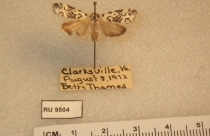Biography: Willard Ellery Treat
by Jessica Sosnicki (2008)
The Biology Department at Radford University has a vast set of specimens collected
over the years. Of that collection, Willard E. Treat contributes a small, but significant
part. Born almost a century and a half ago, there is little known about him and why
his collection ended up at Radford University. However, his specimens are still important
to natural history.
Willard Ellery Treat was born on July 31, 1865 in East Hartford, Connecticut, where
he resided most of his life (U.S. Federal Census, 1870). His father, Ellery Treat,
worked in East Hartford as a bookmaker, while his mother, Eunice, was a homemaker.
According to the 1870 Federal Census, Willard had a sister, Adella (“Della”) G. Treat
as well. Although, the Census did not indicate other siblings, he also had two brothers,
William Howard Treat and Edwin Cuyler Treat (Warner, 1902). Around the age of 20,
Willard attended Wesleyan College in Middletown, Connecticut not far from his hometown.
In college, he was a member of Alpha Alpha, a Wesleyan chapter of Chi Psi. The Sixth
Decennial Catalogue of Chi Psi states he was part of the Class of 1888 (Warner, 1902).
However, Willard only attended one year at Wesleyan; he left during his sophomore
year. His two brothers also attended Wesleyan. Like his brother, William Treat left
his second year. Out of the three brothers, Edwin Cuyler Treat is the only one that
actually graduated from Wesleyan, in 1894. Willard E. Treat married on May 4, 1897
to Emma Brooks Shipman. They were married for over 40 years, until she died while
on vacation in Fort Myers, Florida on November 29, 1938. A year later, in 1939, Julia
Lansing Kelsey became his wife (U.S. Federal Census, 1930). They lived on Res 524
Main Street in his hometown, East Hartford, Connecticut. There is no record of her
death. Nancy Finlay, the Curator of Graphics of the Connecticut Historical Society,
stated no children were mentioned in the Federal Census of 1930. According to an article
Nancy Finlay found in the Hartford Courant on July 23, 1922, Willard cultivated 10
acres of tobacco in the Silver Lane section of East Hartford. He had been a tobacco
grower for over 40 years. In the 1895 and 1911 edition of Zoologisches Adressbuch, Treat is also listed as an ornithologist. Another contact, Suzy Taraba, Wesleyan’s
University Archivist and Head of Special Collections of the Olin Library, discovered
that Willard Ellery Treat died on May 9, 1955. This information was found in the Alumni
Record of 1961, although Willard did not graduate from Wesleyan. In the 1952 edition
of the Wesleyan University Alumni Record, more is stated about Willard Treat:
“Treat, Willard Ellery. Chi Psi. b July 31, 1865, East Hartford. Left fr yr; tobacco
grower 1897-1923; mem Am Ornithologist Union 1886-1904; taxidermist 1882-1930; pub
articles on outdoor life; m May 4, 1897 Emma Brooks Shipman who d 1938; m Julia Lansing
Kelsey 1939. Red 524 Main St, East Hartford.”
Even with this information, it is difficult to uncover more in-depth information on
his background. One thing is for certain, Willard died in a place he rarely ventured
from during his life, East Hartford, Connecticut.
Life as an Ornithologist and Author
Willard Ellery Treat started his interest in ornithology at a young age. He was a
member of the American Ornithologist Union (AOU) from 1886-1904. During this time,
Willard published a series of small articles in The Auk. All of the specimens described in The Auk were found in Connecticut. In addition, he also published an article in Science titled ‘Great Horned Owls in Confinement’ in 1893. This article showed that Willard
could author nature journals with fine detail and observation. Willard is also cited
in The Birds of Connecticut (1913) by John Hall Sage, Louis Bennett Bishop, and Walter Parks Bliss. He is mentioned
several times throughout the publication where he observed and helped identify birds
for the authors. These birds include the double-crested cormorant, pintail, ruddy
duck, among others. One bird Willard collected, the yellow-headed blackbird, was given
to John H. Sage for his collection in Portland, Connecticut.
Treat Specimens
Although little is known today about Willard E. Treat, his specimens can found in
a number of places. The University of Connecticut holds over 1900 animal specimens,
most of which are birds. As described on the university’s website, “The collection
began with the donation of study skins, (dated between 1875 to 1925) from the private
collections of J.H. Sage and W.E. Treat, and emphasizes the fauna of Connecticut and
the northeastern U.S.” (University of Connecticut, 2004). Susan Hochgraf, Vertebrate
Collections Manager of Biological Research Collections at University of Connecticut,
found two of Willard’s ledger books. The first volume is dated January 1, 1887, a
year after he left college. In this ledger, he included dates, specimen numbers, Latin
names, sex, body measurements, stomach contents, and remarks strictly on bird species.
In the first page, he signed his name, followed by his location, East Hartford, CT.
In addition, there is a small note, stating the donation of some of his specimens
to California, Ohio, Pennsylvania, and New York. The second volume includes the same
field data, but with mammals, such as bats and shrews. This volume is dated January
1891 through 1915. The meticulousness of Willard’s ledgers shows he was a true naturalist.
The Smithsonian Museum of Natural History houses a very small collection of Treat’s
specimens, which includes a song sparrow, four sharp-tailed sparrows, and a redstart.
James Dean, Collection Manager of the Smithsonian Institute’s Division of Birds, indicated
that all six specimens were collected in the 1890s.
Radford University has a small collection of 29 Willard Treat’s bird specimens, none
of which are on display. All of the specimens were collected between 1885 and 1896.
The specimens include: one cedar waxwing, one rose-breasted grosbeak, two common redpolls,
three common grackles, two brown-headed cowbirds, three rusty blackbirds, two Swainson's
thrushes, two American pipits, one black-capped chickadee, two cerulean warblers,
two northern parulas, one yellow-rumped warbler, one American redstart, one red-breasted
nuthatch, four white-breasted nuthatch, and one ruby-crowned kinglet. There is still
no explanation as to why Radford University houses these specimens. No written documentation
has been found indicating donations from Willard, the University of Connecticut, or
the Smithsonian.
Works Cited
- [1870] U.S. Federal Census (Population Schedule), East Hartford, Hartford County,
Connecticut, (Treat household).
- [1930] U.S. Federal Census (Population Schedule), East Hartford, Hartford County,
Connecticut, (Treat household).
- Askins, R. (2002). Restoring North America's Birds: Lessons from Landscape Ecology.
New Haven and London: Yale University Press.
- Boyle, W. (2002). A Guide to Bird Finding in New Jersey. New Jersey: Rutgers University
Press.
- Department of Environmental Protection. (2008). Endangered, Threatened and Special
Concern Species in Connecticut. Retrieved October 12, 2008, from Department of Environmental
Protection site: http://www.ct.gov/dep/cwp/view.asp?a=2702&q=323472&depNav_GID=1628
- Sage, J. H., Bishop L. B., & Bliss W. P. (1913). The Birds of Connecticut. Hartford,
CT: The Case, Lockwood, & Brainard Co.
- Treat, W. E. (1893). Great Horned Owls in Confinement. Science, 22, 137-139.
- University of Connecticut (2004). Biological Collections: Bird Collections. Retrieved
September 12, 2008 from
http://collections2.eeb.uconn.edu/collections/birds/birds.html

